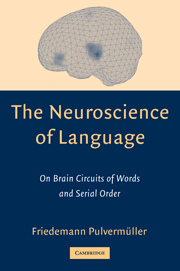Book contents
- Frontmatter
- Contents
- Preface
- The Neuroscience of Language
- 1 A Guide to the Book
- 2 Neuronal Structure and Function
- 3 From Classic Aphasia Research to Modern Neuroimaging
- 4 Words in the Brain
- Excursus E1 Explaining Neuropsychological Double Dissociations
- 5 Regulation, Overlap, and Web Tails
- 6 Neural Algorithms and Neural Networks
- 7 Basic Syntax
- 8 Synfire Chains as the Basis of Serial Order in the Brain
- 9 Sequence Detectors
- 10 Neuronal Grammar
- 11 Neuronal Grammar and Algorithms
- Excursus E2 Basic Bits of Neuronal Grammar
- Excursus E3 A Web Response to a Sentence
- 12 Refining Neuronal Grammar
- Excursus E4 Multiple Reverberation for Resolving Lexical Ambiguity
- Excursus E5 Multiple Reverberations and Multiple Center Embeddings
- 13 Neurophysiology of Syntax
- 14 Linguistics and the Brain
- References
- Abbreviations
- Author Index
- Subject Index
Excursus E2 - Basic Bits of Neuronal Grammar
Published online by Cambridge University Press: 15 December 2009
- Frontmatter
- Contents
- Preface
- The Neuroscience of Language
- 1 A Guide to the Book
- 2 Neuronal Structure and Function
- 3 From Classic Aphasia Research to Modern Neuroimaging
- 4 Words in the Brain
- Excursus E1 Explaining Neuropsychological Double Dissociations
- 5 Regulation, Overlap, and Web Tails
- 6 Neural Algorithms and Neural Networks
- 7 Basic Syntax
- 8 Synfire Chains as the Basis of Serial Order in the Brain
- 9 Sequence Detectors
- 10 Neuronal Grammar
- 11 Neuronal Grammar and Algorithms
- Excursus E2 Basic Bits of Neuronal Grammar
- Excursus E3 A Web Response to a Sentence
- 12 Refining Neuronal Grammar
- Excursus E4 Multiple Reverberation for Resolving Lexical Ambiguity
- Excursus E5 Multiple Reverberations and Multiple Center Embeddings
- 13 Neurophysiology of Syntax
- 14 Linguistics and the Brain
- References
- Abbreviations
- Author Index
- Subject Index
Summary
How does neuronal grammar operate? The following examples further illustrate the activation processes taking place in a network of neuronal sets during perception of congruent or grammatically well-formed and incongruent or ill-formed strings. This excursus aims to illustrate the principled difference in network dynamics between the processing of congruent and incongruent word strings, and further aims to introduce illustration schemes for network dynamics that are used in later sections of the book (see E3–E5 Chapters 11, 13).
Although the general mechanism of serial-order detection, mediated sequence detection by sequence sets, is simple, the interaction of several neuronal sets can become quite complex. To make their activity dynamics easy to overlook, two strategies are used to illustrate processes in grammar networks. One strategy is to list activity states of all sets contributing to the processing of a string at each point in time when a string element is present in the input and shortly thereafter. Activity dynamics are therefore presented in the form of tables. A second strategy is to present the simulations as animations. The animations, including illustrations of the three examples presented in this excursus, are available on the Internet at this book's accompanying web-page (http://www.cambridge.org).
Examples, Algorithms, and Networks
Strings such as (1), (2), or (3) could be taken as examples for illustrating the function of a simple grammar network.
- Type
- Chapter
- Information
- The Neuroscience of LanguageOn Brain Circuits of Words and Serial Order, pp. 215 - 223Publisher: Cambridge University PressPrint publication year: 2003



